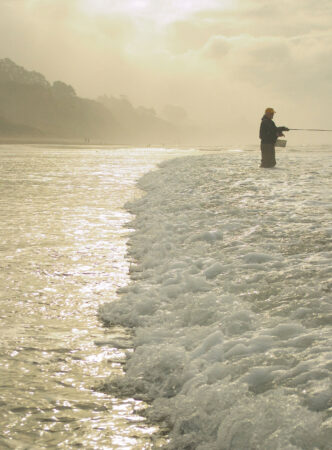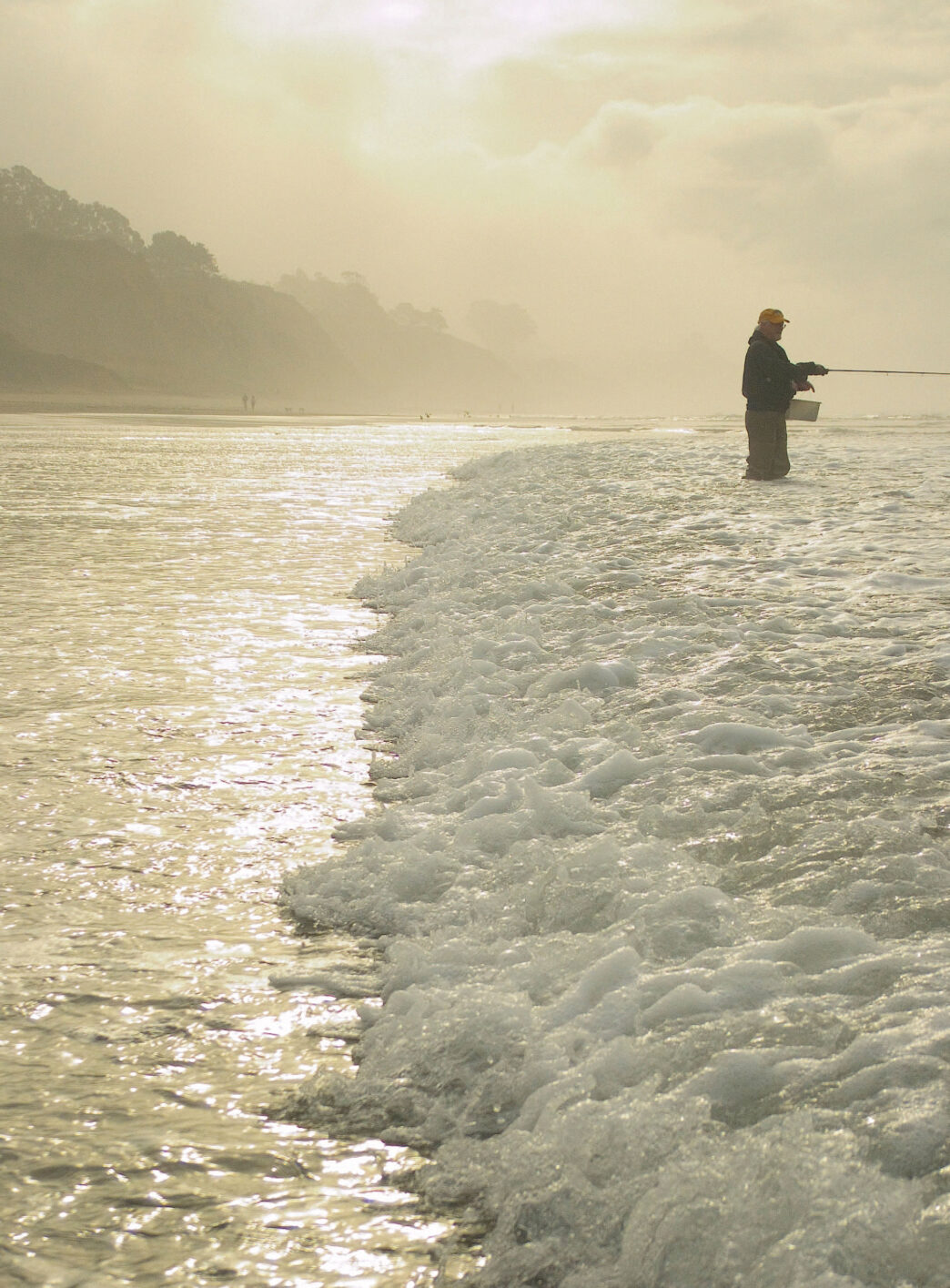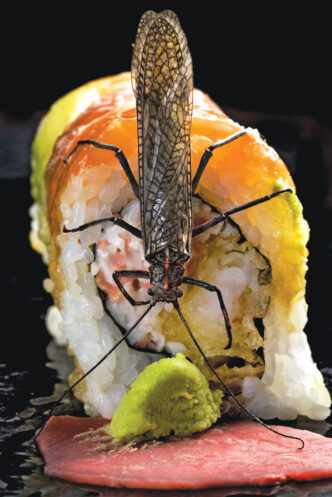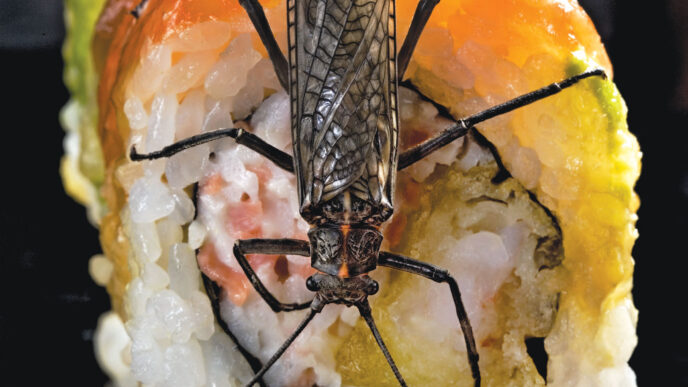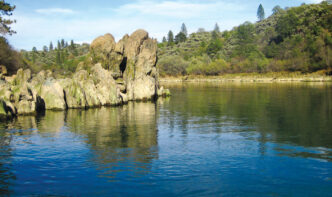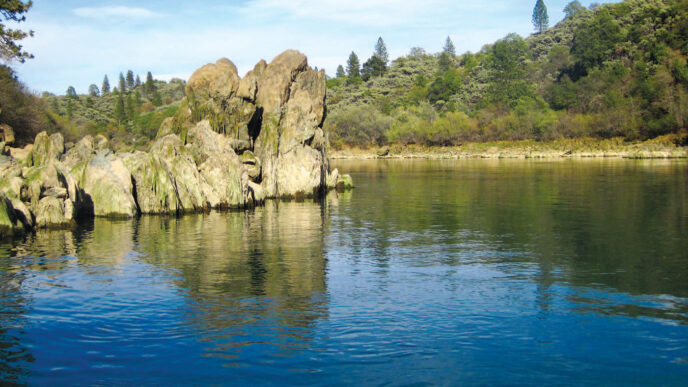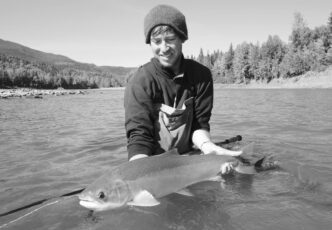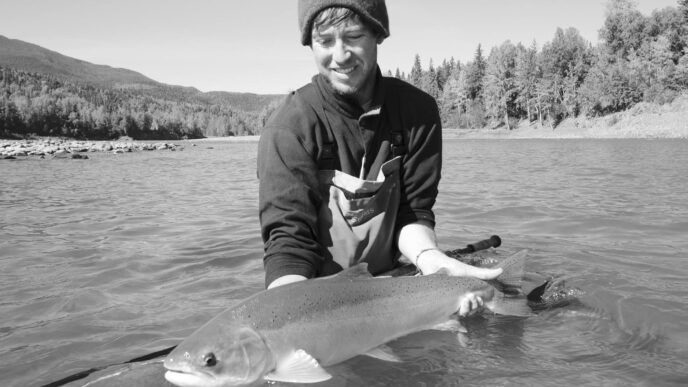The sun is climbing over the hard edges of tract homes lining the highway. No fog today, unusual in summertime. Soon houses recede as hills rise in a tan patchwork that ends in steep bluffs falling toward the ocean. It’s a long drop to a curving crescent of sand and the sound of cracking surf.
I park the car, assemble the fly rod, and pull on waders. Locating the trail at the head of the bluff, I start down, watching swell lines far out on the glassy sea. A squadron of pelicans cruises by in formation, and seen from this height, their bodies seem to skim just inches above the water.
Some days, it is so foggy out here you need a dowsing rod just to find the water. But on this morning, the ocean shines like a jewel that can’t be bought or sold. A nutritious light falls on the immense, blue Pacific. The surf couldn’t be finer — a clean swell rising three to five feet out of the southwest. Bottle-green waves lift upward toward the sun, and the white foam seems to have caught fire.
Out beyond the breakers, a gentle groundswell uplifts and lowers. The waves break and roll toward the beach in churning lines of foam. There is a point, however, where the water begins to re-form into new, smaller waves that go on to break only yards away from shore. It is on this second, inside break, in the trough, where one can fly fish.
I stand in the sand, contemplating the surf. Wade out too far, and the waves will knock you sideways. And don’t even think about turning your back on the ocean. Big rollers sneak in from out of nowhere on this coast, even on calm days.
The morning breeze isn’t so stiff that fly casting will be a problem. By noon on summer days, head-on winds coming off the ocean can make it impossible to fly fish off the beaches here. But the early morning hours usually are calm enough for the task. The shore I’m fishing seems to obtain some measure of protection from the bluffs that shield the beach from the wind’s worst effects.
I strip line off the reel, flex the long rod, and fire a cast into a trough that forms between the waves. A small wave smacks me hard, nearly throwing me off balance. I back up to where I can remain reasonably steady on my feet, draw more line off the reel into the stripping basket, and cast out as far as my ability allows. I try to make the fly swim along with the current, which runs parallel to the beach, and I follow the fly’s underwater movements with the tip of my rod. No doubt there will be surfperch in the shallows, feasting on sand eels and mole crabs. But I’m after striped bass in slightly deeper water.
Catching striped bass with a fly rod in the California surf is exactly as hard as it looks. The sea is so huge and the sight of it so overwhelming that it can fill a fly fisher with awe and something close to trepidation. Fly fishing is often thought of as a sport that is fun and relaxing. But “relaxation” is hardly the word I would use to describe what is going on in the surf. With every cast, I am made aware that I am fishing in the largest body of water on the planet. Stripers are built to rummage in heavy water. They work the exploding surf line, hunting for anchovies and similar baitfish, attacking sand eels and mole crabs, even small surfperch. I look around for a sign of feeding gulls, always an indicator that there is action below the surface, but so far, the seabirds are not present in meaningful numbers.
I proceed up the beach, following the pull of current, casting at different angles to the flow so as to cover as much water as possible. I look for sandbars angling out from the beach or running parallel to it within my casting range. They are not hard to spot, if you know what you’re looking for. I watch white water break over one such bar and then disappear quickly, indicating a hole just behind the bar. Often, such holes are prime feeding stations for striped bass, but when I run my fly through the bucket, nothing happens.
A little farther up the beach, I notice a break in the white water where a tidal rip flows out to sea. Water that has washed up on shore is collecting and rushing back out through a narrow corridor that runs perpendicular to the beach. Tidal rips provide natural lanes for predatory fish to travel back and forth through the various troughs that form along the beach in between sandbars. There is a greater concentration of suspended food in these rips, and so a greater concentration of baitfish, providing targets for predators.
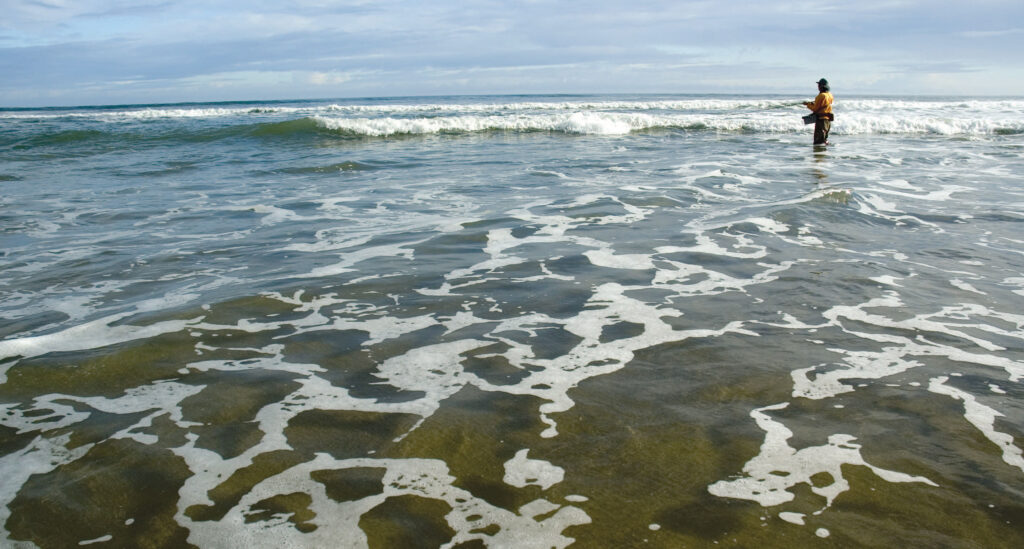
I move to the edge of the rip and cast my fly into the undertow, working it as I would the current of a river. The waves roll up and down the beach, seeming to wash away everything but the moment: the cries of gathering gulls, the play of sunlight on foam and water, the clean draughts of salt air I am breathing. Suddenly, I feel a hard tug on my line and remember to pull the rod straight back, rather than merely upward, simultaneously yanking line with my free hand. Too many times I have lost fish because I simply raised upward on a strike and the giving bend wouldn’t allow a good hook set. This time, I create a straight pull between the fish and me and feel solid resistance as the long rod curves fully, its tip holding low toward the waves.
As the bass surges, loose line coiled in the stripping basket flies through the rod guides until it comes up tight against the reel, which surrenders it in tortured spasms. Forty yards of line and backing whine over the sound of crashing surf. The rod plunges under the strain as the striped bass reverses direction, circling widely under the waves. I stay fast to it, keeping a stout bend in the rod, the tip straining downward, at times almost touching the water. There are moments when it feels like I am fighting the ocean more than the fish. On the outgoing waves, the striper seems to gain ground; on the incoming waves, I have the advantage. Gradually, I can feel the lunging bass begin to weaken. I pump it back toward me, the long rod plunging and recovering. Pumping harder, I raise the rod high to draw the bass in and then lower it quickly to reel in more line. Repeating this maneuver several times, it isn’t long before I have all my backing and running line back on the reel. The striper continues to struggle, but only half-heartedly, and I know it is on its last gasp.
I back up toward the beach so as to get the fish into shallow water. Fully exhausted, the striper hangs in a trough close by until a gentle wave lifts it up, helping to glide the fish toward my free hand. Avoiding the sharp spines along the dorsal and pectoral fins, I reach down and seize the bass by its lower lip, feeling the rough sandpaper finish inside the creature’s mouth. My holding it firmly by the lip causes the fish to freeze.
The bass gleams like a mirror held up to the sea. Its dorsal side is an oceanic green, with hints of gray, a camouflage for marauding seabirds. Seven horizontal black stripes run from the gill plate to the base of the tail, and these stand out against the mirrored silver on the sides. The underbelly is like mother of pearl. Most beautiful of all, perhaps, are the eyes, with their black pupils and golden irises. What does the underwater world look like to a striped bass? I can only wonder.
Holding the striper steady by the tail, I begin to push the exhausted fish back and forth in the water to revive it. I let go when the bass begins to kick. At first, it seems uncertain that it is free, but then darts away, disappearing as an underwater shadow, lost in the confusion beneath the waves. The last glimpse I have of it, it is heading into the heart of the ocean’s mystery. Facing the surf, I can feel the breeze stiffening. I retreat from the ocean and begin the long climb back up the cliff to the parked car. Huffing up the trail, every now and again I turn around to catch my breath and contemplate the blue world behind me. When you stand on a beach, you can only see for about 12 miles. But up on the headlands, the view is vastly different and greatly expanded. For one thing, you can see many more miles out to sea. At times, the views seem limitless. Today, the inshore water is green glass and farther out a fathomless liquid blue, all the way to where the horizon bends at the edge of the world. The sky above seems as fragile as an eggshell, yet infinite. I resolve to come back here first thing tomorrow.



